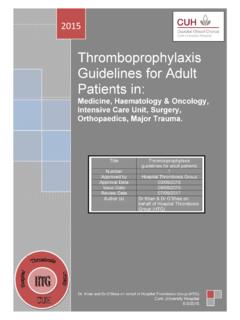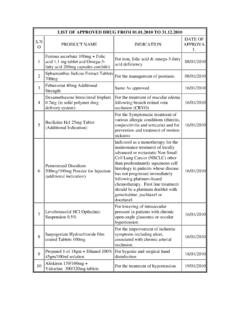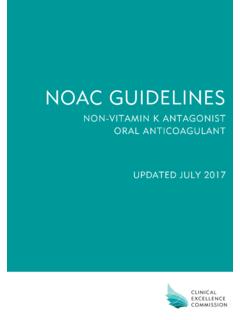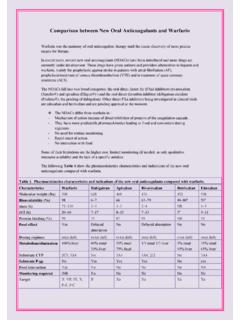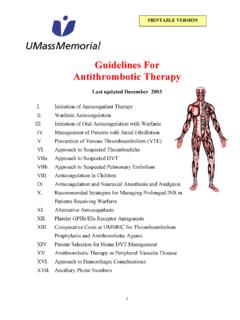Transcription of DRUG NAME: Atezolizumab - BC Cancer
1 Atezolizumab (interim monograph) drug name : Atezolizumab SYNONYM(S): MPDL3280A1 COMMON TRADE name (S): TECENTRIQ CLASSIFICATION: molecular targeted therapy Special pediatric considerations are noted when applicable, otherwise adult provisions apply. MECHANISM OF ACTION: Atezolizumab is a humanized IgG1 monoclonal antibody immune checkpoint inhibitor that binds to programmed death-ligand 1 (PD-L1) and blocks the interaction with PD-1 and B7-1 receptors on T-lymphocytes. PD-L1 is an immune check point protein expressed on tumour cells and tumour- infiltrating immune cells that down regulates anti-tumour T-cell function; blocking these receptors restores anti-tumour T-cell ,3 USES: Primary uses: Other uses: Urethral cancer2 Lung Cancer , non-small cell2 *Health Canada approved indication SPECIAL PRECAUTIONS: Caution: avoid systemic corticosteroids or immunosuppressants prior to starting Atezolizumab due to potential interference with the efficacy of Atezolizumab ; corticosteroids or immunosuppressants may be used during treatment with Atezolizumab in the management of immune-mediated adverse SIDE EFFECTS: The table includes adverse events that presented during drug treatment but may not necessarily have a causal relationship with the drug .
2 Because clinical trials are conducted under very specific conditions, the adverse event rates observed may not reflect the rates observed in clinical practice. Adverse events are generally included if they were reported in more than 1% of patients in the product monograph or pivotal trials, and/or determined to be clinically important5. ORGAN SITE SIDE EFFECT Clinically important side effects are in bold, italics blood and lymphatic system/ febrile neutropenia anemia (severe 8%) lymphopenia (severe 10%) endocrine (see paragraph following Side Effects table) adrenal insufficiency (<1%) hyperthyroidism (1%) hypophysitis (<1%) BC Cancer Agency Cancer drug Manual Page 1 of 5 Atezolizumab (interim monograph) Developed: 1 April 2017 Revised: 1 May 2017 (NOC) Atezolizumab (interim monograph) ORGAN SITE SIDE EFFECT Clinically important side effects are in bold, italics hypothyroidism (3-4%, severe <1%) eye ocular inflammatory toxicity (<1%) gastrointestinal emetogenic potential: low6 abdominal pain (17%, severe 4%) colitis (19%, severe 1%); see paragraph following Side Effects table constipation (20-21%, severe ) diarrhea (18%, severe 1%).
3 See paragraph following Side Effects table dysphagia (severe >2%) intestinal obstruction (severe >2%) nausea (22-25%, severe 2%) pancreatitis (<1%); see paragraph following Side Effects table retroperitoneal hemorrhage (<1%) vomiting (17%, severe 1%) general disorders and administration site conditions extravasation hazard: none7 fatigue (46-52%, severe 6%) fever (18-21%, severe 1%) peripheral edema (18%, severe 1%) immune system (see paragraph following Side Effects table) encephalitis (<1%) Guillain-Barr syndrome (<1%) hepatitis (1%); sometimes fatal hyperthyroidism (1%) hypophysitis (<1%) hypothyroidism (3-4%, severe <1%) infusion related reaction (1-2%) meningitis ( <1%) myasthenia gravis/myasthenic syndrome (<1%) ocular inflammatory toxicity (<1%) pancreatitis (<1%) pneumonitis (3%); sometimes fatal infections and infestations encephalitis (<1%) infection (38-43%, severe 9-12%).
4 Sometimes fatal, have included sepsis, herpes encephalitis, and mycobacterial infection meningitis (<1%) pneumonia (18%, severe 6-8%) urinary tract infection (22%, severe 7-9%) investigations alkaline phosphatase increase (42%, severe 2-4%) BC Cancer Agency Cancer drug Manual Page 2 of 5 Atezolizumab (interim monograph) Developed: 1 April 2017 Revised: 1 May 2017 (NOC) Atezolizumab (interim monograph) ORGAN SITE SIDE EFFECT Clinically important side effects are in bold, italics (see paragraph following Side Effects table) ALT increase (31%, severe 2%) AST increase (33%, severe 2%) bilirubin increase (11%) creatinine increase (19%, severe 1-3%) metabolism and nutrition appetite decrease (26-35%, severe 1%) dehydration (severe >2%) diabetes mellitus (<1%) hypercalcemia (13%) hyperglycemia (severe 5%); see paragraph following Side Effects table hypoalbuminemia (48%, severe 1-5%) hypokalemia (18%, severe 2%) hyponatremia (48%, severe 10-13%) musculoskeletal and connective tissue arthralgia (14-16%, severe 1-2%) back/neck pain (14-15%, severe 1-2%) myasthenia gravis/myasthenic syndrome (<1%) psychiatric insomnia (14%) renal and urinary acute kidney injury (severe >2%) hematuria (14%, severe 3%) urinary obstruction (severe >2%) respiratory, thoracic and mediastinal cough (14-30%, severe 1 %) dyspnea (16-32%, severe 4-7%) hypoxia (severe >2%) pneumonia (8%, severe >2%) pneumonitis or interstitial lung disease (3-4%, severe 1-2% ).
5 Sometimes fatal skin and subcutaneous tissue pruritis (13%, severe <1 %) rash (15%, severe <1 %) vascular venous thromboembolism (severe >2%) Adapted from standard reference2 unless specified otherwise. Immune-mediated adverse events are a spectrum of side effects caused by general immunologic enhancement that can occur at any time during Atezolizumab treatment. The etiology for any reported endocrinopathies, diarrhea/colitis, hepatitis, nephritis, pneumonitis, and rash should be considered as immune-mediated until another etiology is confirmed. Symptoms can be severe or fatal if not recognized and treated quickly; therefore, patients should not self-treat without medical advice. Management of symptoms depends on the severity of the reaction and may require treatment interruption and/or administration of corticosteroids. Corticosteroids should be appropriately tapered following resolution of symptoms to grade 1 or less.
6 Atezolizumab may be restarted following completion of the steroid taper depending on the severity of the initial reaction. Referral to appropriate medical specialty may be required to manage other immune-mediated complications related to treatment. Antibiotic prophylaxis should be considered for patients on long term corticosteroid treatment ( , oral BC Cancer Agency Cancer drug Manual Page 3 of 5 Atezolizumab (interim monograph) Developed: 1 April 2017 Revised: 1 May 2017 (NOC) Atezolizumab (interim monograph) trimethoprim/sulfamethoxazole for the prevention of Pneumocystis jiroveci pneumonia). Permanent discontinuation of Atezolizumab should be considered for: grade 3-4: pneumonitis, immune-mediated hepatitis (AST or ALT greater than 5 times upper limit of normal (ULN) or bilirubin greater than 3 times ULN), infusion-related reactions, or ocular toxicities grade 4: diarrhea, colitis, pancreatitis, rash, or hypophysitis2 Immune-mediated endocrinopathies include: thyroid disorders, adrenal insufficiency diabetes mellitus and hypophysitis and Other less common, but clinically significant, Atezolizumab immune-related reactions include: meningoencephalitis, myasthenic syndrome/myasthenia gravis, Guillain-Barr syndrome, and ocular inflammatory Severe infections including sepsis, herpes encephalitis, pneumonia, and mycobacterial infection leading to retroperitoneal hemorrhage have been reported.
7 Withhold Atezolizumab for grade 3/4 For mild to moderate infusion-related reactions, interrupt or slow infusion rate. Consider premedication with antipyretics and antihistamines for subsequent infusions. Permanently discontinue for grade 3 or 4 SUPPLY AND STORAGE: Injection: Hoffman La Roche, supplies Atezolizumab as 1200 mg ready-to-use single use (preservative-free) vials in a concentration of 60 mg/mL. Refrigerate. Protect from light. Do not For basic information on the current brand used at the BC Cancer Agency, see Chemotherapy Preparation and Stability Chart in Appendix. SOLUTION PREPARATION AND COMPATIBILITY: For basic information on the current brand used at the BC Cancer Agency, see Chemotherapy Preparation and Stability Chart in Appendix. Additional information: Compatibility: consult detailed reference PARENTERAL ADMINISTRATION: BCCA administration guideline noted in bold, italics Subcutaneous no information found Intramuscular no information found Direct intravenous do not use2 Intermittent infusion over 30-60 min2,8 first infusion is given over 60 minutes.
8 If tolerated, subsequent infusions can be given over 30 min2,8 Continuous infusion no information found Intraperitoneal no information found Intrapleural no information found Intrathecal no information found Intra-arterial no information found Intravesical no information found BC Cancer Agency Cancer drug Manual Page 4 of 5 Atezolizumab (interim monograph) Developed: 1 April 2017 Revised: 1 May 2017 (NOC) Atezolizumab (interim monograph) DOSAGE GUIDELINES: Refer to protocol by which patient is being treated. Numerous dosing schedules exist and depend on disease, response and concomitant therapy. Guidelines for dosing also include consideration of absolute neutrophil count (ANC). Dosage may be reduced, delayed or discontinued in patients with bone marrow depression due to cytotoxic/radiation therapy or with other toxicities.
9 Adults: BCCA usual dose noted in bold, italics Cycle Length: Intravenous: 3 weeks4,8,9: 1200 mg IV for one dose on day 1 (total dose per cycle 1200 mg) dose reductions are NOT recommended REFERENCES: 1. Powles T, Eder JP, Fine GD, et al. MPDL3280A (anti-PD-L1) treatment leads to clinical activity in metastatic bladder Cancer . Nature 2014;515(7528):558-562. 2. Genentech Inc. TECENTRIQ full prescribing information. South San Francisco, CA, USA; October 2016. 3. AHFS drug Information (database on the Internet). Atezolizumab . Lexi-Comp Inc., 8 September 2016. Available at: Accessed 24 February 2017. 4. Rosenberg JE, Hoffman-Censits J, Powles T, et al. Atezolizumab in patients with locally advanced and metastatic urothelial carcinoma who have progressed following treatment with platinum-based chemotherapy: a single-arm, multicentre, phase 2 trial.
10 Lancet 2016;387(10031):1909-1920. 5. Sunil Parimi MD. Personal communication. BC Cancer Agency Genitourinary Tumour Group; 4 Apr 2017. 6. BC Cancer Agency. (SCNAUSEA) Guidelines for Prevention and Treatment of Chemotherapy-induced Nausea and Vomiting in Adults. Vancouver, British Columbia: BC Cancer Agency; 1 Mar 2012. 7. BC Cancer Agency Provincial Systemic Therapy Program. Provincial Systemic Therapy Program Policy III-20: Prevention and Management of Extravasation of Chemotherapy. Vancouver, British Columbia: BC Cancer Agency; January 2016. 8. Hoffman-La Roche Limited. TECENTRIQ product monograph. 7070 Mississauga Road, Ontario; 12 April 2017. 9. Fehrenbacher L, Spira A, Ballinger M, et al. Atezolizumab versus docetaxel for patients with previously treated non-small-cell lung Cancer (POPLAR): a multicentre, open-label, phase 2 randomised controlled trial.










